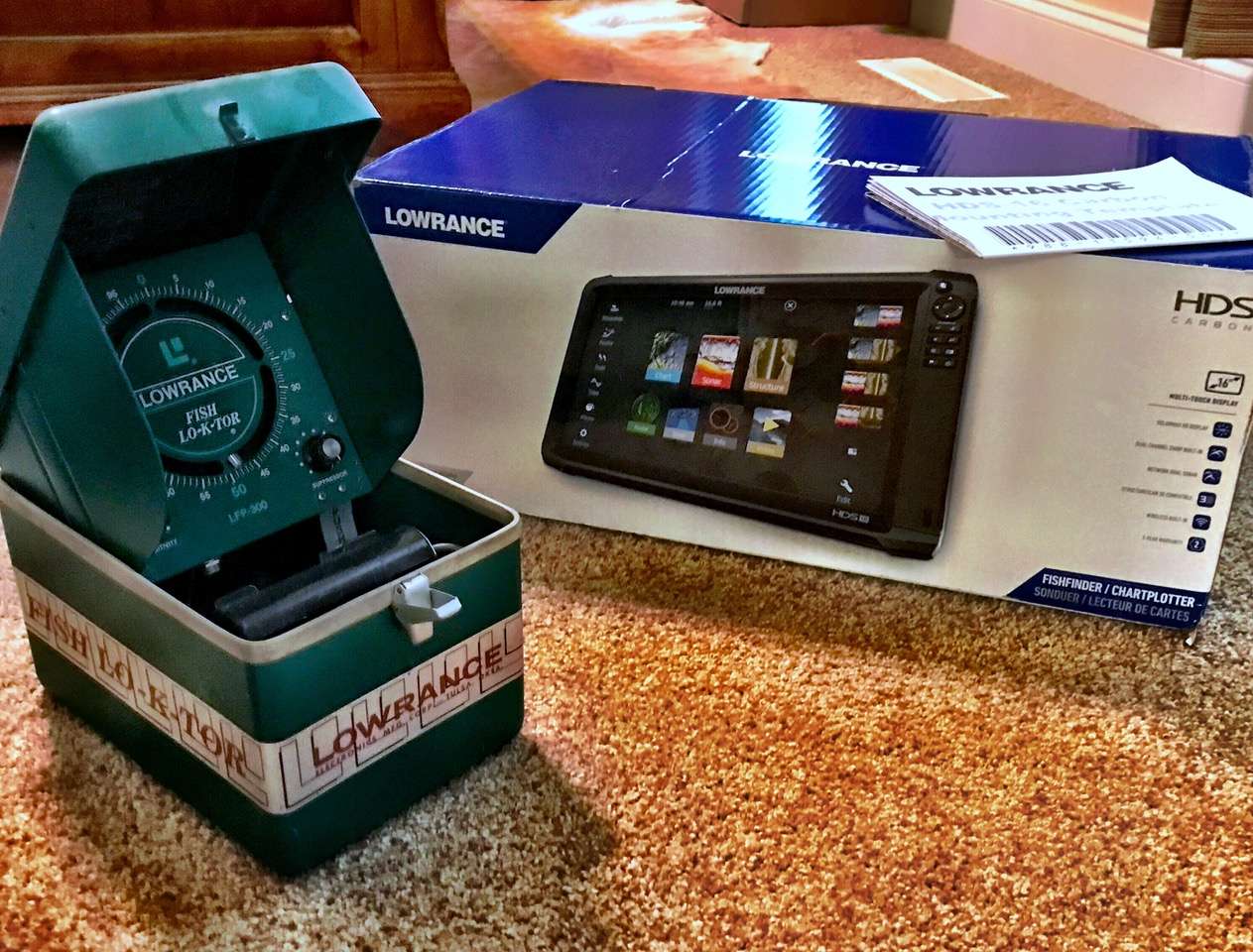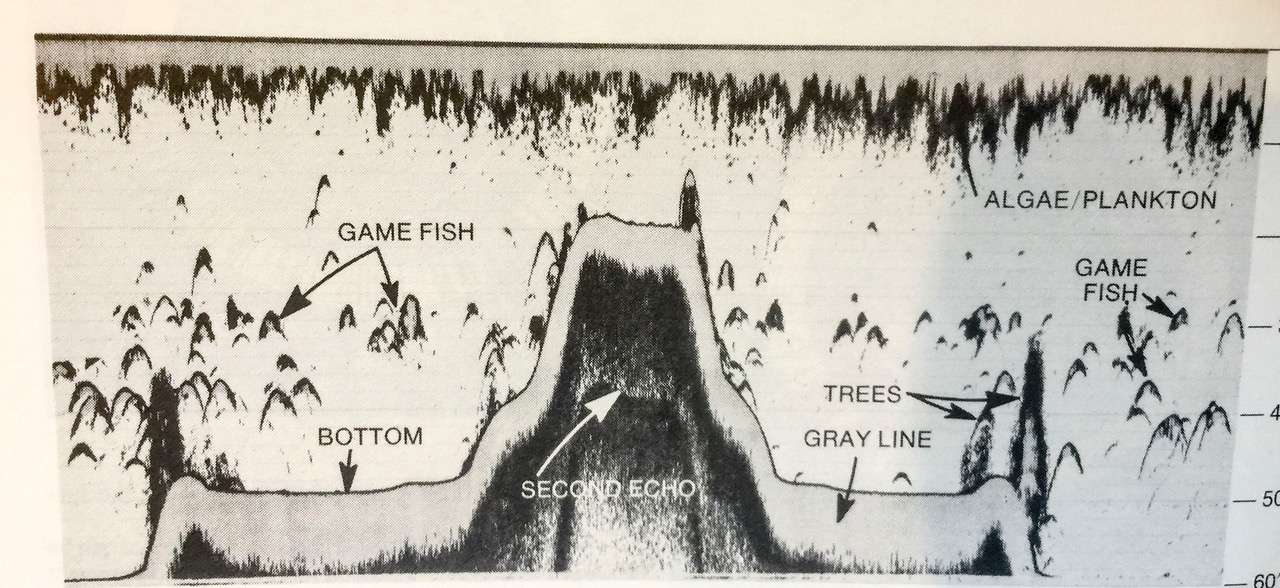
As a professional bass angler I get this question a lot: In terms of tackle and equipment, what do you think has evolved the most in bass fishing? The boats? More fuel-efficient outboards? Smaller, lighter reels? Improvements in fishing line? Better rods?
And without hesitation I always say electronics – electronics have far and away seen the most advancements through the years. I thought about this very thing the other day as I snapped a picture of my very first portable Lowrance flasher – the “little green box” as they called it back in the day – sitting next to my brand new 16-inch HDS Carbon unit. In between those two “fish finders” lies 30 years of unbelievable advancements.
The Lowrance “Fish Lo-K-Tor,” as it was named, was my first look into the underwater world electronically. That thing had a suction cup transducer that you had to “stick on” the side or transom of the boat. Nothing about it was wired into the boat – not even the power. It ran on two 6-volt batteries that powered a spinning dial, which lit up with each sonar return. It hummed and it purred and it flicked and flashed with light. It was up to the angler to decipher what the heck all that flashing meant. The brighter the light, the “harder” the return. Bright red flashes between the surface and the bottom was the good stuff. Needless to say, I fed that “little green box” a lot of batteries.
Following the flasher, the next big advancement in electronics was the “paper graph.” I bet some of the young pros on tour today have never even seen a paper graph. These were the first units that could actually draw a picture of what was going on under the boat. When I say “draw,” I do mean actually draw, as a stylus etched onto paper what the transducer was reading.
In order to make these machines work, you had to feed them rolls of carbon paper. As you idled along, the stylus would scribble on the scrolling paper – like an old EKG machine. In order to get the machine to draw clearly you had to idle at just the right speed and dial in all the knobs that controlled sensitivity, paper scrolling speed, stylus pressure – it was like dialing in an old ham radio to pick up signals from Europe. Once you got it dialed though, it would draw detailed pictures of rock, brush, roadbeds, sunken bridges and of course fish, with the telltale fish “arcs” Lowrance made so famous.

To this day a lot folks think those arcs on their depthfinders are some kind of international fish symbol made up by electronic companies. But those arcs are formed by fish as they pass through the transducer cone. At the far edge of the cone the signal is weaker so the line is thin. But as the fish moves through the cone the signal gets stronger, forming a thicker, darker line that “humps” up before thinning back out.
The best part of the paper graph was when you got home, you could take your used paper out of the graph and cut out the sweet spots that featured breaks, ledges or some kind of structure on the bottom. I used to keep these paper graph records and write notes on them about what I caught on each spot and where they were located. Keep in mind, this was long before GPS, so in order to find these spots again I had to use a paper map, compass and a lot of triangulation.
The biggest problem with paper graphs was they had a lot of moving parts to them. Scrolling paper, a rotating stylus and it ate carbon paper.
Sometime around the mid 1980s liquid crystal technology made an appearance in the fish finder world, replacing paper with an LCD or LCR screen. The first couple of generations of these units were not exactly “HD” to say the least. They had huge pixels and tiny screens – not a good combination. So for several years the dispute about which was better – flashers or LCDs – was a common topic among pros.
That score was eventually settled with the advent of GPS technology for bass boats. Lowrance’s Global Map 2000 blew the fishing world away when it integrated positioning, mapping and sonar into one unit. Having all three in one unit allowed the LCD type displays to really distance itself from flasher units. Like flat screen TVs, generations of electronics that followed grew in size with more pixels, definition, mapping and processing power.
More recently the advent of sidescan and downscan has brought yet another quantum leap in fish-finding technologies. What these ultrasound-like images allow us to see in the water borders on surreal. It’s like seeing the surface of the moon for the first time.
And the list of advancements goes on with Wi-Fi capability, the ability to create your own maps and using satellite image overlays. This year I will be running three units, two HDS Carbon units with 12-inch screens and one with a whopping 16-inch screen – that’s 40 inches of flat screen dedicated to finding bass.
What’s even crazier is I don’t think these innovations in electronics are anywhere near slowing down. When I wirelessly “mirror” movies from my phone to my TV I have to wonder how much longer it will be before we just have one central computer secured safely in a compartment that processes all of the sonar and GPS info and “streams” it wirelessly to only screens in our consoles and bows. Can you imagine having thin, flat screens without the wires, other than power?
Hey, I don’t know, maybe it’s not even possible. But then again, when I bought my first little green box 30 years ago, I never dreamed that having 40 inches of fish finding power at my fingertips would be possible. And look where we are now.

